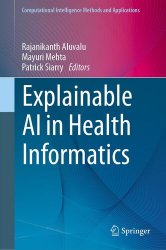Explainable AI in Health Informatics
- Добавил: literator
- Дата: 8-07-2024, 17:26
- Комментариев: 0
 Название: Explainable AI in Health Informatics
Название: Explainable AI in Health InformaticsАвтор: Rajanikanth Aluvalu, Mayuri Mehta, Patrick Siarry
Издательство: Springer
Серия: Computational Intelligence Methods and Applications
Год: 2024
Страниц: 287
Язык: английский
Формат: pdf (true), epub
Размер: 38.9 MB
This book provides a comprehensive review of the latest research in the area of Explainable Artificial Intelligence (XAI) in health informatics. It focuses on how explainable AI models can work together with humans to assist them in decision-making, leading to improved diagnosis and prognosis in healthcare. This book includes a collection of techniques and systems of XAI in health informatics and gives a wider perspective about the impact created by them. The book covers the different aspects, such as robotics, informatics, drugs, patients, etc., related to XAI in healthcare.
The book is suitable for both beginners and advanced AI practitioners, including students, academicians, researchers, and industry professionals. It serves as an excellent reference for undergraduate and graduate-level courses on AI for medicine/healthcare or XAI for medicine/healthcare. Medical institutions can also utilize this book as reference material and provide tutorials to medical professionals on how the XAI techniques can contribute to trustworthy diagnosis and prediction of the diseases.
This book is a collection of 12 chapters that provide an overview of recent advances in this area, that is, how Explainable Artificial Intelligence techniques help provide trustworthy solutions in healthcare. The target audience of this book is researchers, practitioners, and students. A brief description of each chapter is given below.
Chapter 1 extensively discusses various fundamental underpinnings, methodologies, and implementation frameworks of XAI. The bedrock of XAI lies in the urgency to demystify the internal mechanisms of AI models, rendering their decision-making transparent for human stakeholders.
Chapter 2 addresses the capabilities of XAI frameworks to achieve accountability, transparency, result tracing, and model improvement. It discusses various XAI methods, use cases, and different application areas of XAI.
Chapter 3 discusses the use of deep learning in the real world and various datasets in the healthcare domain. It also discusses the transition from healthcare 1.0 to healthcare 6.0 and the use of XAI in various aspects of healthcare.
Chapter 4 introduces available XAI toolkits for experimental purposes and potential avenues for future developments in XAI. These aid researchers in exploring healthcare-oriented applications and contribute to advancing the healthcare 5.0 paradigm...
Скачать Explainable AI in Health Informatics
Внимание
Уважаемый посетитель, Вы зашли на сайт как незарегистрированный пользователь.
Мы рекомендуем Вам зарегистрироваться либо войти на сайт под своим именем.
Уважаемый посетитель, Вы зашли на сайт как незарегистрированный пользователь.
Мы рекомендуем Вам зарегистрироваться либо войти на сайт под своим именем.
Информация
Посетители, находящиеся в группе Гости, не могут оставлять комментарии к данной публикации.
Посетители, находящиеся в группе Гости, не могут оставлять комментарии к данной публикации.
